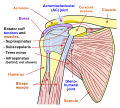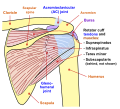Supraspinatus muscle
Supraspinatus muscle is a muscle that is part of the rotator cuff group, located in the shoulder. It is situated in the supraspinatus fossa, a concave depression in the rear portion of the scapula, or shoulder blade. The primary function of the supraspinatus muscle is to assist in the abduction of the arm at the shoulder joint.
Anatomy[edit]
The supraspinatus muscle originates from the supraspinatus fossa, a concave depression in the superior portion of the scapula, and inserts into the greater tubercle of the humerus. It is one of the four muscles that make up the rotator cuff, along with the infraspinatus muscle, teres minor muscle, and subscapularis muscle.
Function[edit]
The primary function of the supraspinatus muscle is to assist in the abduction of the arm at the shoulder joint. It also helps to stabilize the shoulder joint by keeping the head of the humerus in the glenoid cavity during arm movement.
Clinical significance[edit]
Injury to the supraspinatus muscle or its tendon, such as a rotator cuff tear, can cause pain and loss of function in the shoulder. This is a common injury in athletes and older adults. Treatment may include physical therapy, medication, or surgery.
See also[edit]
External links[edit]
- Supraspinatus muscle at PubMed Health
- Supraspinatus muscle at InnerBody.com
| Muscles of the arm | ||||||||||||||||||||||||||||||||||||||||||||
|---|---|---|---|---|---|---|---|---|---|---|---|---|---|---|---|---|---|---|---|---|---|---|---|---|---|---|---|---|---|---|---|---|---|---|---|---|---|---|---|---|---|---|---|---|
|
| Shoulder Anatomy and Conditions | ||||||||
|---|---|---|---|---|---|---|---|---|
|
| Muscles | ||||||||||
|---|---|---|---|---|---|---|---|---|---|---|
This muscle related article is a stub.
|
-
Supraspinatus muscle back view
-
Supraspinatus muscle diagram
-
Supraspinatus muscle animation
-
Arm muscles back view with numbers
-
Shoulder motion with rotator cuff (supraspinatus)
-
Shoulder joint diagram
-
Shoulder joint back view
Ad. Transform your life with W8MD's Budget GLP-1 injections from $75


W8MD offers a medical weight loss program to lose weight in Philadelphia. Our physician-supervised medical weight loss provides:
- Weight loss injections in NYC (generic and brand names):
- Zepbound / Mounjaro, Wegovy / Ozempic, Saxenda
- Most insurances accepted or discounted self-pay rates. We will obtain insurance prior authorizations if needed.
- Generic GLP1 weight loss injections from $75 for the starting dose.
- Also offer prescription weight loss medications including Phentermine, Qsymia, Diethylpropion, Contrave etc.
NYC weight loss doctor appointmentsNYC weight loss doctor appointments
Start your NYC weight loss journey today at our NYC medical weight loss and Philadelphia medical weight loss clinics.
- Call 718-946-5500 to lose weight in NYC or for medical weight loss in Philadelphia 215-676-2334.
- Tags:NYC medical weight loss, Philadelphia lose weight Zepbound NYC, Budget GLP1 weight loss injections, Wegovy Philadelphia, Wegovy NYC, Philadelphia medical weight loss, Brookly weight loss and Wegovy NYC
|
WikiMD's Wellness Encyclopedia |
| Let Food Be Thy Medicine Medicine Thy Food - Hippocrates |
Medical Disclaimer: WikiMD is not a substitute for professional medical advice. The information on WikiMD is provided as an information resource only, may be incorrect, outdated or misleading, and is not to be used or relied on for any diagnostic or treatment purposes. Please consult your health care provider before making any healthcare decisions or for guidance about a specific medical condition. WikiMD expressly disclaims responsibility, and shall have no liability, for any damages, loss, injury, or liability whatsoever suffered as a result of your reliance on the information contained in this site. By visiting this site you agree to the foregoing terms and conditions, which may from time to time be changed or supplemented by WikiMD. If you do not agree to the foregoing terms and conditions, you should not enter or use this site. See full disclaimer.
Credits:Most images are courtesy of Wikimedia commons, and templates, categories Wikipedia, licensed under CC BY SA or similar.
Translate this page: - East Asian
中文,
日本,
한국어,
South Asian
हिन्दी,
தமிழ்,
తెలుగు,
Urdu,
ಕನ್ನಡ,
Southeast Asian
Indonesian,
Vietnamese,
Thai,
မြန်မာဘာသာ,
বাংলা
European
español,
Deutsch,
français,
Greek,
português do Brasil,
polski,
română,
русский,
Nederlands,
norsk,
svenska,
suomi,
Italian
Middle Eastern & African
عربى,
Turkish,
Persian,
Hebrew,
Afrikaans,
isiZulu,
Kiswahili,
Other
Bulgarian,
Hungarian,
Czech,
Swedish,
മലയാളം,
मराठी,
ਪੰਜਾਬੀ,
ગુજરાતી,
Portuguese,
Ukrainian






